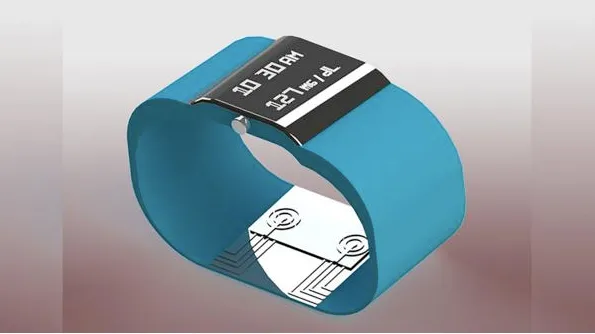fer
07/13/2016 11:01 a.m.
The device, created by Mexican scientists, allows to avoid analysis by extraction of a blood sample.The results can be checked through an application on the cell phone.
The measurement of sugar in the body is a determining factor for those who suffer from diabetes or can even present symptoms of that disease.So far, the only way to perform the analysis was by extraction of a blood sample.Until today.
A group of scientists from the Center for Scientific and Higher Education Research of Ensenada (CICESE), in Baja California, USA, designed a novel bracelet capable of measuring glucose in the skin.
The device, designed thanks to the help of the National Autonomous University of Mexico (UNAM), can be controlled thanks to an app on the cell phone, where the results of each study will be projected.
"It is a glucometer itself. We measure the concentration of glucose in the skin, which provides exactly the same parameters as blood glucose," said José Antonio Tejeda Rodríguez, one of the leaders of the investigation.
According to developers, the bracelet has a minimum margin of error and similar to that of traditional glucometers."Through a chemical method we extract glucose. Then a potential between two electrodes for three minutes is applied, and then the corresponding chemical measurement is performed," said Tejeda Rodríguez.
The bracelet can also be scheduled to perform periodic controls in patients.At the moment, the device was not marketed.It is expected to reach the public in mid -2017.
Diabetes Tipo 1 desde 1.998 | FreeStyle Libre 3 | Ypsomed mylife YpsoPump + CamAPS FX | Sin complicaciones. Miembro del equipo de moderación del foro.
Autor de Vivir con Diabetes: El poder de la comunidad online, parte de los ingresos se destinan a financiar el foro de diabetes y mantener la comunidad online activa.
Sígueme en Instagram
I'm glad that options of this type are coming out, I hope someone really marketed, at least it is a way of pressing so that the current ones improve.
Mamá de María. 15 años. Diagnósticada 05/06/2015
Humalog
Tresiba
@RocioLlinares
Última hemo 6,1
LuVi
07/13/2016 12:40 p.m.
These types of advances are what we should have and be using.The truth is that the news attracts .... But sincerely the explanation of how the measurement is made, the less it is a bit surreal, perhaps they should have focused more the report on a clear and sustained explanation about the way of measuring.Hopefully it is not smoke and it is a reality, although it seems first.
DMT1 desde los 12 años (1991)
hbA1c= 6,2
Humalog y Toujeo (mayo 2017)
Humalog y Tresiba (mayo 2016 hasta mayo 2017)
humalog y NPH (desde inicio hasta mayo de 2016)
I suppose it will have some type of "hook" to the skin, microagujas or something like a velcro ... and the chemical method will have to enter the dermis in some way.
We will see if it is marketed or in the end it has any disadvantage for health.
Lada enero 2015.
Uso Toujeo y Novorapid.
They don't tell anything about how they work, they show nothing, they just put a drawer made with a computer.
Smoke, smoke and more smoke.
En 1922 descubrieron la insulina, en 1930 la insulina lenta. ¿Que c*** han hecho desde entonces?
I have investigated more in detail the origin of the news, I confirm that the real state of the bracelet in question has been exaggerated, it is only a prototype made by some students !!!, here I copy more information:
A prototype of biosensor that measures the levels of glucose in the skin, without the need to extract blood from the patient, was designed by three students of the Master in Material Physics offered by the Center for Scientific Research and Higher Education of Ensenada(CICESE) jointly with the Nanosciences and Nanotechnology Center (CNYN) of the National Autonomous University of Mexico (UNAM).
The bracelet -shaped device, being in contact with the user's wrist and through nearby field communication technology (NFC) and an application for mobile devices (app), transmits the level informationof bearer glucose to a smartphone.
“It is a glucometer itself, we measure the concentration of glucose that is on the skin, that concentration of the skin is exactly the same as the blood, so we, by means of a chemical method, extract the glucose, a potential is applied betweenTwo electrodes for three minutes and then, since the glucose of the skin is extracted, we make a chemical measurement too, ”said José Antonio Tejeda Rodríguez, one of the students who designed the prototype.

In an interview with the Conacyt informative agency, he said that the measurement made by the device is very accurate, since it has a minimum margin of error, similar to that of traditional glucometers;However, it also provides the option to share information with other people, thanks to the application for mobile devices.
The bracelet also offers the possibility of being scheduled for periodic measurements to the patient and stores the data collected to keep a record in the cell phone app, where the information is displayed.
business innovation with social impact
The project in which José Antonio Tejeda, David Shimomoto Sánchez and Iván Antonio Peralta Mendoza participate, won in June the Santander Award for Business Innovation 2016.
The contest was a key piece to encourage students to work from the subject of Master's thesis of David Shimomoto and specify it in the prototype that competed with more than a thousand business projects developed by students from universities throughout the country.
José Antonio Tejeda commented that one of the requirements to participate in the contest is to prepare a business plan and contemplate the social impact of the project, which gave rise to the search for diabetes related statistics.
“Basically the data we get are from the International Diabetes Federation and 11 million Mexicans with diabetes are identified in 2015 and give an estimate that 300 thousand new cases are increased every year, so it is a rather real and quite serious problemin which we were able to venture with the generation of this biosensor, ”he said.
He clarified that while the elaboration of the business plan proves the feasibility of the project, the device is not yet ready to be launched to the market;However, they will continue to make adjustments and improvements to the prototype.
Diabetes Tipo 1 desde 1.998 | FreeStyle Libre 3 | Ypsomed mylife YpsoPump + CamAPS FX | Sin complicaciones. Miembro del equipo de moderación del foro.
Autor de Vivir con Diabetes: El poder de la comunidad online, parte de los ingresos se destinan a financiar el foro de diabetes y mantener la comunidad online activa.
Sígueme en Instagram
They should not allow such deceptive headlines ..
Hija de 35 años , diabética desde los 5. Glico: normalmente de 6 , pero 6,7 la última ( 6,2 marcaba el Free)
Fiasp: 4- 4- 3 Toujeo: 20
fer
07/14/2016 12:23 a.m.
@Regina you are right, the news of the newspapers sometimes has to take with tweezers ... #-o
Diabetes Tipo 1 desde 1.998 | FreeStyle Libre 3 | Ypsomed mylife YpsoPump + CamAPS FX | Sin complicaciones. Miembro del equipo de moderación del foro.
Autor de Vivir con Diabetes: El poder de la comunidad online, parte de los ingresos se destinan a financiar el foro de diabetes y mantener la comunidad online activa.
Sígueme en Instagram
Unfortunately we are getting used to ... to see if we are lucky and among so many news that they are worthless, the good comes out and get something really useful.
Padre de Jesús. Bomba insulina y dexcom g4 share. Debut con 18 meses....ya con 7 añitos...Hemo entorno a 7....y mucha lucha diaria.....ya sabéis..poco dormir y bastantes miedos....pero mi niño es feliz luego yo también.
JVH
11/12/2017 12:47 p.m.
I would have to be available, I don't know why these things are expected so much.And the "FIASP" insulin, a couple of years ago that exists, already available in some countries, why don't you get here?
No signature configured, add it on your user's profile.








